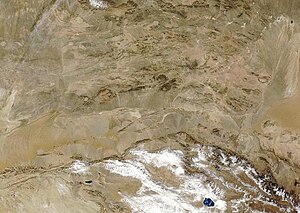Ejin River
| Ruo Shui (弱水) | |
| Heishui, Etsin-gol, Ruo He | |
| River | |
|
Satellite view of the deserts of northern China. The Ruo River is visible as the faint green trace to the right of the image.
|
|
| Name origin: Named for the seasonal flows in its lower course | |
| Country | China |
|---|---|
| States | Gansu, Inner Mongolia |
| Tributaries | |
| - left | Dang He, Beida He |
| City | Zhangye |
| Source | Kan Chou and Hsü Chao springs |
| - location | Qilian Shan, Gansu |
| - elevation | 3,650 m (11,975 ft) |
| - coordinates | 38°00′04″N 100°54′45″E / 38.00111°N 100.91250°E |
| Mouth | Badain Jaran Playa |
| - location | Badain Jaran Desert, Inner Mongolia |
| - elevation | 900 m (2,953 ft) |
| - coordinates | 42°18′50″N 101°04′20″E / 42.31389°N 101.07222°ECoordinates: 42°18′50″N 101°04′20″E / 42.31389°N 101.07222°E |
| Length | 630 km (391 mi) |
| Basin | 78,600 km2 (30,348 sq mi) approx. |
Ruo Shui (Chinese: 弱水, literally: "weak river", also Etsin Gol or Ruo He or Ejin River) is a major river system of northern China. It flows approximately 630 kilometres (390 mi) from its headwaters on the northern Gansu side of the Qilian Mountains north-northeast into the endorheic Ejin Basin in the Gobi Desert. The river forms one of the largest inland deltas or alluvial fans in the world. Its drainage basin covers about 78,600 square kilometres (30,300 sq mi) in parts of the Chinese provinces of Gansu and Inner Mongolia.
The river rises as the Heishui (黑水, black river) on the north slopes of the Qilian Mountains roughly 75 kilometres (47 mi) southeast of Minle. It flows north then northwest past Zhangye, picking up several tributaries from the south. For the first 150 kilometres (93 mi) its water is used to irrigate fields along its valley. It then turns north-northeast, flowing out into the desert, and becoming a losing stream as its water sinks into the surrounding earth. This quality is what gives the river its name, as it greatly lessens the flow and even causes it to dry up in some years. From the turn it runs about 175 kilometres (109 mi) in that direction onto a vast alluvial plain formed by the river's sediment deposits. This part of the river is also known as the Etsin Gol or Etsin River. At Ximiao, the river splits into two ephemeral distributaries called the Dong He (東河, eastern river) and the Xi He (西河, western river), each about 220 kilometres (140 mi) long, draining into the Juyan Lake Basin. The Dong empties into a lake called Sogo Nur, while the Xi river empties into a seasonal basin called the Gaxun Nur.
The Ruo River has created over the past few million years one of the largest inland river deltas or alluvial fans in the world. Sediments deposited by the river span across a massive area 300 kilometres (190 mi) long and 200 kilometres (120 mi) across. The delta is crossed by hundreds of dry channels entrenched by the river during its frequent course changes. Because the climate of the area has followed a drying trend over the past 10,000 years or so, the delta is no longer considered active (i.e. deposits are not being built up significantly) and is slowly being eroded by wind and water action.
...
Wikipedia

